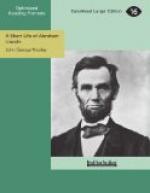In Washington, with this singular exception, the manifestation of public grief was immediate and demonstrative. Within an hour after the body was taken to the White House, the town was shrouded in black. Not only the public buildings, the shops, and the better residences were draped in funeral decorations, but still more touching proof of affection was seen in the poorest class of houses, where laboring men of both colors found means in their penury to afford some scanty show of mourning. The interest and veneration of the people still centered in the White House, where, under a tall catafalque in the East Room, the late chief lay in the majesty of death, and not at the modest tavern on Pennsylvania Avenue, where the new President had his lodging, and where Chief-Justice Chase administered the oath of office to him at eleven o’clock on the morning of April 15.
It was determined that the funeral ceremonies in Washington should be celebrated on Wednesday, April 19, and all the churches throughout the country were invited to join at the same time in appropriate observances. The ceremonies in the East Room were brief and simple—the burial service, a prayer, and a short address; while all the pomp and circumstance which the government could command was employed to give a fitting escort from the White House to the Capitol, where the body of the President was to lie in state. The vast procession moved amid the booming of minute-guns, and the tolling of all the bells in Washington Georgetown, and Alexandria; and to associate the pomp of the day with the greatest work of Lincoln’s life, a detachment of colored troops marched at the head of the line.
As soon as it was announced that Mr. Lincoln was to be buried at Springfield, Illinois, every town and city on the route begged that the train might halt within its limits and give its people the opportunity of testifying their grief and reverence. It was finally arranged that the funeral cortege should follow substantially the same route over which he had come in 1861 to take possession of the office to which he had given a new dignity and value for all time. On April 21, accompanied by a guard of honor, and in a train decked with somber trappings, the journey was begun. At Baltimore through which, four years before, it was a question whether the President-elect could pass with safety to his life, the coffin was taken with reverent care to the great dome of the Exchange, where, surrounded with evergreens and lilies, it lay for several hours, the people passing by in mournful throngs. The same demonstration was repeated, gaining continually in intensity of feeling and solemn splendor of display, in every city through which the procession passed. The reception in New York was worthy alike of the great city and of the memory of the man they honored. The body lay in state in the City Hall, and a half-million people passed in deep silence before it. Here General Scott came, pale and feeble, but resolute, to pay his tribute of respect to his departed friend and commander.




